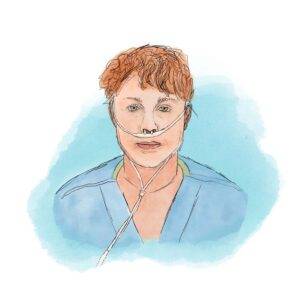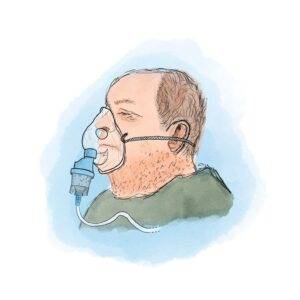Transtracheal Oxygen Therapy (TTO2)
People who need oxygen supplementation due to severe lung disease most often use nasal cannulas (or occasionally a facemask) in the outpatient setting. Transtracheal Oxygen Therapy (TTO2) is the method that delivers oxygen directly into the trachea (windpipe) through a very thin tube via a tiny opening in the base of your neck. Think by analogy of a large plastic IV needle that goes into the airway rather than a vein. Or imagine a “micro-tracheotomy.”
Because this method of administration provides oxygen more directly into the airway/lungs, oxygen flow can often be reduced by half. If using a cannister of oxygen rather than a concentrator, time per tank would double. Furthermore, a smaller cannister might work for trips away from home.
Other advantages of TTO2
Nasal cannulas can cause dryness, nasal sores, or nosebleeds and are cosmetically unappealing. The longer tubing may interfere with daily activities. Because of the discomfort, many patients do not wear their oxygen 24 hours per day, even though studies show continuous oxygen therapy improves health outcomes.
Who is a candidate for TTO2?
Any patient who needs long term oxygen therapy may be considered for TTO2. His or her motivation will depend upon nasal cannula issues such as comfort and cosmesis, it may also be advantageous if blood oxygen saturation remains low in spite of high flow rates via nasal cannula.
A few reasons that may preclude TTO2 include severe anxiety, inability to clean or otherwise care for the catheter, excessive mucus (phlegm), living more than an hour from medical care, and certain anatomical limitations.
What is involved in taking care of the catheter?
At the start, the catheter is cleaned in place with a cleaning rod twice daily. Once the tract is mature, the patient may remove the catheter, reinsert a clean one, and clean the one removed as needed—typically once or twice per day. Catheters and oxygen hoses should be replaced (i.e., switched out—no “procedure” involved) with new ones every 90 days.
What is the follow-up schedule?
Once a person begins using oxygen through the catheter and until the tract is mature, patients visit their doctors once or twice per week for catheter care. When the tract has matured, most follow-up with the pulmonologist.
How is the procedure done?
There are two ways of placing the TTO2 catheter: Videoendoscopic Seldinger and FastTract.
The Videoendoscopic Seldinger procedure is done in an office procedure room. The neck is cleansed, and anesthetic medicine injected into the front of the neck. Then, the nose, throat, and windpipe are also numbed with anesthetic spray to allow the placement of a scope into the trachea without causing coughing. The scope allows the doctor to see the entry point for the catheter and to watch on the video monitor as the procedure is done. A needle is inserted into the (topically anesthetized) windpipe. The needle tract is then dilated, and the catheter is positioned and then secured in place. After instruction in care of the catheter, the patient goes home, still using the nasal cannula. At your follow-up visit in one week, the oxygen is connected to the TTO2 catheter. The tract usually matures in six to eight weeks.
Alternatively, the FastTract procedure is done at the hospital in an operating room. The anesthesiologist administers sedation. Anesthetic medicine is injected into the neck over the windpipe. A small skin incision is made and some of the fatty layer removed in a small area. A small punch of cartilage is removed from the windpipe and a stent is inserted. The skin is sutured to the underlying muscle/trachea to help hold the tract open. After a brief stop in the recovery room, the patient stays overnight in the hospital. The following morning, the stent is exchanged for the TTO2 catheter, oxygen is started, and the patient is discharged to home. The tract usually matures in two weeks.
FastTract vs. Videoendoscopic Seldinger
To compare and contrast these two, the Videoendoscopic Seldinger procedure saves the inconvenience and cost of the operating room and overnight hospital stay, but use of the catheter is delayed by a week, and it takes longer for the tract to mature. The FastTract procedure costs more because of the operating room and overnight hospital stay, but the catheter can be used the day after the procedure and the tract matures more rapidly.
The use and care of the catheter as the tract matures and afterward is the same, regardless of the procedure used.
What are the possible complications?
Complications of TTO2 catheter placement are infrequent. The more common, minor problems include:
- Triggering wheezing
- Bubbles of air escaping (temporarily) into the skin
- Low grade infection of the tracheal cartilage (chondritis)
- Formation of scar (keloid) or inflammatory tissue (granulation) at the catheter site
Some patients may experience problems with mucus balls accumulating on the catheter. Rare possible major complications include abscess in the tract, collapsed lung (pneumothorax), and bleeding.


